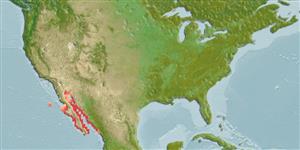Environment: milieu / climate zone / depth range / distribution range
Écologie
marin récifal; profondeur 5 - 30 m (Ref. 9342). Subtropical; 33°N - 23°N, 119°W - 106°W (Ref. 5222)
Eastern Central Pacific: southern La Jolla, California, USA to Mazatlan, Mexico.
Taille / Poids / Âge
Maturity: Lm ? range ? - ? cm
Max length : 198 cm TL mâle / non sexé; (Ref. 2850); poids max. publié: 91.0 kg (Ref. 5222)
Épines dorsales (Total): 11; Rayons mous dorsaux (Total): 16-17; Épines anales 3; Rayons mous anaux: 10 - 11. Distinguished by the following characteristics: uniform dark brown or grey color of adults (can rapidly change into juvenile pattern when disturbed or under stress), large adults with white pectoral fin margin and median fins with narrow white edge; juvenile with greyish brown color, with dark spots along upper half of the body; depth of body 3.1-3.4 times in SL; head length 2.5-2.7 times in SL; rounded preopercle, finely serrate, lacking distinct lobe at the angle; posterior nostrils not notably enlarged, diameter less than twice of anterior nostrils (Ref. 89707).
Found in rocky reefs and kelp beds. Juveniles are unknown in California waters and the few large adults that have been taken there are probably expatriates from a more southerly breeding population. Large adults feed on fishes (Ref. 9342). Reported to prey on juvenile hammerhead sharks. Its large size makes it an object of game fishing (Ref. 9342).
Life cycle and mating behavior
Maturité | Reproduction | Frai | Œufs | Fécondité | Larves
Heemstra, P.C. and J.E. Randall, 1993. FAO Species Catalogue. Vol. 16. Groupers of the world (family Serranidae, subfamily Epinephelinae). An annotated and illustrated catalogue of the grouper, rockcod, hind, coral grouper and lyretail species known to date. Rome: FAO. FAO Fish. Synop. 125(16):382 p. (Ref. 5222)
Statut dans la liste rouge de l'IUCN (Ref. 130435)
Menace pour l'homme
Harmless
Utilisations par l'homme
Pêcheries: intérêt commercial mineur; pêche sportive: oui
Plus d'informations
RéférencesAquacultureProfil d'aquacultureSouchesGénétiqueElectrophoresesHéritabilitéPathologiesTraitementNutrientsMass conversion
CollaborateursImagesStamps, Coins Misc.SonsCiguateraVitesseType de nageSurface branchialeOtolithesCerveauxVision
Outils
Articles particuliers
Télécharger en XML
Sources Internet
Estimates based on models
Preferred temperature (Ref.
123201): 18.6 - 25.9, mean 23 °C (based on 102 cells).
Phylogenetic diversity index (Ref.
82804): PD
50 = 0.5000 [Uniqueness, from 0.5 = low to 2.0 = high].
Bayesian length-weight: a=0.00933 (0.00429 - 0.02028), b=3.04 (2.87 - 3.21), in cm total length, based on LWR estimates for this Genus-body shape (Ref.
93245).
Niveau trophique (Ref.
69278): 4.5 ±0.80 se; based on food items.
Résilience (Ref.
120179): Très faible, temps minimum de doublement de population supérieur à 14 ans (Preliminary K or Fecundity.).
Fishing Vulnerability (Ref.
59153): Very high vulnerability (90 of 100).
Nutrients (Ref.
124155): Calcium = 8.75 [4.91, 18.12] mg/100g; Iron = 0.397 [0.198, 0.722] mg/100g; Protein = 19.5 [17.7, 21.3] %; Omega3 = 0.163 [0.086, 0.304] g/100g; Selenium = 19.6 [7.2, 42.9] μg/100g; VitaminA = 50.7 [13.8, 195.3] μg/100g; Zinc = 0.454 [0.295, 0.715] mg/100g (wet weight);
